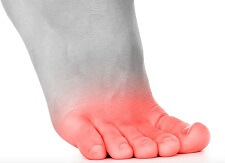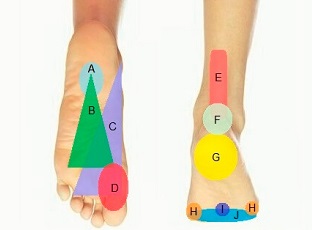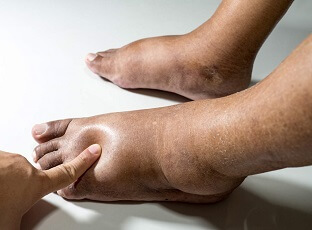- Home
- Common Foot Problems
- Foot Rashes
- Red Feet
Why Are My Feet Red?
Written By: Chloe Wilson BSc(Hons) Physiotherapy
Reviewed By: FPE Medical Review Board
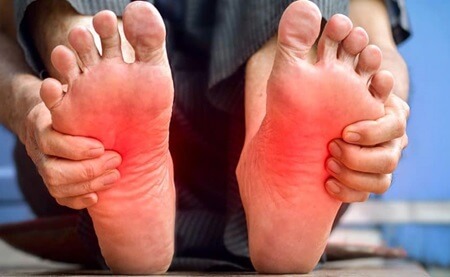
Are your feet red? Are they itchy, swollen or have small red spots?
There are lots of possible causes of red feet, from allergic reactions to infections, inflammation to a foot injury, vascular problems to skin conditions.
Foot redness may develop suddenly or gradually, be constant or intermittent, acute (short term) or chronic (long term), painful or non-tender.
While sometimes a red foot is completely harmless and temporary, it can also be a sign of underlying health issues that require attention. Here we will explore the possible reasons for red feet, associated symptoms, causes, when to seek medical advice and the best treatment options.
Common Symptoms With Red Feet
Red feet may present with a variety of accompanying symptoms including:
- Warmth: The affected area of the foot may feel warm or even hot to the touch
- Swelling: Red feet are often accompanied by swelling, making the area appear puffy
- Pain or Discomfort: Some people experience pain, tenderness, or a burning sensation with foot redness. It may even be uncomfortable to wear socks or shoes
- Itchiness: In some cases, foot redness is paired with itching, particularly in skin conditions
- Altered Sensation: Red feet may be accompanied by tinging or numbness
- Dryness or Peeling Skin: Skin changes like flaking or cracking may occur in certain conditions
- Visible Veins: Enlarged or prominent veins may accompany redness due to circulatory issues
- Feeling Unwell: Foot redness accompanied by general malaise, fever, or chills may indicate an infection or systemic issue.
- Difficulty Walking: Pain, swelling, or other symptoms may make walking uncomfortable or challenging
Recognizing these symptoms can help narrow down the potential causes of why your feet are red.
Causes Of Red Feet
Foot redness can result from a variety of conditions. The most common red feet causes include:
1. Infections
Infections are common causes of red feet, particularly:
- Cellulitis: A bacterial skin infection causing foot redness, swelling, warmth, and tenderness.
- Athlete’s Foot: A fungal infection leading to an itchy, scaly, flaky red foot that stings or burns, particularly between the toes. Highly contagious
- Ringworm: a fungal infection that causes a ring-shaped red circle on the foot
2. Allergic Reactions
One of the most common reasons for red feet is an allergic reaction. Allergies to footwear materials, lotions, or other products can lead to redness and irritation.
- Irritant Contact Dermatitis: Caused by direct exposure to irritating substances like cleaning products, detergents and harsh chemicals, leads to localised foot redness, dryness, blistering and a non-itchy rash
- Allergic Contact Dermatitis: Triggered by an immune response to allergens such as latex, certain plants, adhesives, or certain metals, it causes red spots on feet, extreme itching, and rash-like symptoms.
- Insect Bites: Bites or stings from insects can cause localized red spots on feet, swelling, and itching, which may spread if there is an allergic reaction or infection.
3. Inflammatory Conditions
There are a number of inflammatory conditions that may cause your feet to turn red:
- Gout Foot: A type of arthritis characterized by sudden, severe pain and redness in the joints, often affecting the big toe.
- Erythromelalgia: A rare condition causing burning pain, hot skin and red feet, often triggered by increased body temperature, dehydration or exercise
4. Circulatory Issues
If your feet are red, you may have problems with your circulation such as:
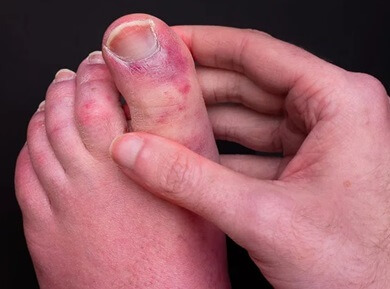
- Venous Insufficiency: Poor vein function leads to blood pooling in the feet, causing redness, swelling, heaviness and foot cramps
- Ischaemia: Reduced blood supply to the tissues can cause severe pain, coldness, weak/absent pulses and changes in foot colour - typically a pale foot when the leg is elevated and red feet when they are down
- Peripheral Artery Disease: Reduced blood flow to the feet can cause burning foot pain especially when walking, changes in skin colour (blue, purple or red feet) and sores or ulcers
- Blood Clot: A blockage in the blood vessels, such as deep vein thrombosis (DVT), can cause redness, swelling, and warmth in the foot or calf
5. Skin Conditions
Red feet causes are often linked to skin conditions such as:
- Eczema: inflammatory skin condition, aka dermatitis, triggered by friction, moisture or an allergic reaction that can cause dry, flaky skin, itching, and red splotches on feet. Recurrent flare-ups are common with foot eczema
- Psoriasis: chronic skin condition that can cause scaly, itchy, red splotches on feet and often other parts of the body as well
- Dermatographia: rare skin condition that causes an allergic reaction when the skin is scratched forming raised, inflamed red lines on feet
6. Foot Injuries
Some foot injuries may cause your foot to turn red, including dropping something heavy onto your foot or kicking something.
- Foot Tendonitis: Inflammation of the tendons in the foot can cause localized redness, pain, and swelling, especially with overuse or injury
- Blisters: Friction or pressure from footwear can lead to fluid-filled pockets on the skin, causing red spots on feet and discomfort in the affected area
7. Temperature-Related Changes
Exposure to hot environments, such as sitting by a heater or soaking in hot water, can cause temporary redness in the feet.
- Chilblains: A reaction to cold temperatures that causes swollen, itchy bumps on the skin and red toes
When To See A Dr With Red Feet
While some cases of red feet are harmless and resolve on their own, it is essential to know when to seek medical advice. Contact a doctor if:
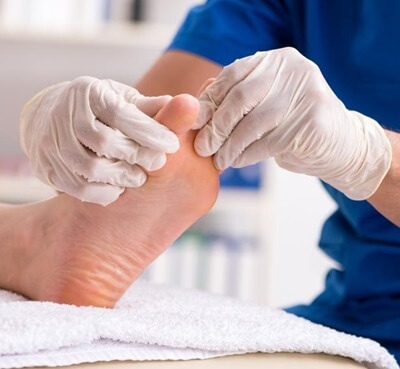
- You have diabetes
- Your red foot is accompanied by severe pain, swelling, or warmth - could indicate infection
- You are unable to walk
- The foot redness persists for more than a few days without improvement
- You experience fever, chills, or other signs of systemic illness
- There is an open wound, ulcers, or signs of poor circulation, such as cool or bluish skin
- You experience numbness, tingling, or other neurological symptoms in your feet
Seek urgent medical attention if you have difficulty breathing, the foot redness is spreading quickly or rapidly worsening, or you have a high, persistent fever.
If your feet are red, your doctor will take a detailed history and carry out a physical examination, including checking foot pulses. Then, depending on the suspected cause, they may send you for blood tests, bacterial/fungal cultures, or imaging studies.
#CommissionEarned from Amazon on qualifying purchases
How To Treat Red Feet
The treatment for red feet depends on the underlying cause but common approaches include:
1. Medications
If your feet are red there are various medications that can help:
- Antibiotics: for infections like cellulitis.
- Antifungal Medication: creams or sprays for fungal infections such as athlete’s foot or ringworm
- Anti-Inflammatory Medications: for conditions like gout, such as colchicine or NSAID’s e.g. ibuprofen
- Topical Steroids: creams or ointments for eczema or dermatitis
- Anti-Histamines: can help reduce itching with red feet and dermatographia e.g. cetirizine
2. Lifestyle Adjustments
Making simple adjustments to your lifestyle can help a number of red feet causes:
- Elevation: Rest with your feet raised above the level of your heart to reduce swelling with circulatory issues e.g. on a leg cushion
- Avoid Triggers: such as heat or specific allergens
- Keep Feet Clean & Dry: to prevent infections
- Rest: from aggravating activities for a few days if you have a foot injury
- Avoid Smoking: as it reduces blood flow to the foot and delays healing
- Ensure Healthy Lifestyle: exercise regularly and have a healthy, low-fat diet
- Stay Hydrated: ensure you are drinking plenty of fluids
3. Compression Therapy
Compression stockings or tubigrip compression bandage can help improve blood flow in cases of venous insufficiency.
4. Physical Therapy
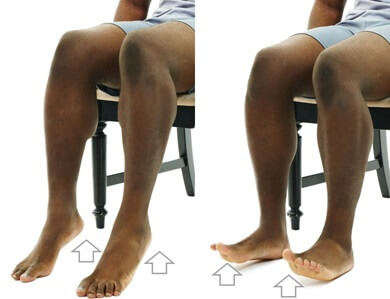
Simple exercises can help to improve circulation or address neurological issues associated with red feet.
For example, when sitting, regularly pump your feet up and down or bend and straighten your knees to keep the blood pumping through your legs. Aim to move every 30 minutes.
5. Specialist Care
Consultation with a dermatologist, podiatrist, or vascular specialist may be needed for chronic or severe cases of red feet. In some cases, surgery may be recommended, usually if there is a blockage in the vascular system which is impeding blood flow to the foot.
FAQ's About Red Feet
Why Do My Feet Get Red When Standing?
Why Do My Feet Get Red When Standing?
The most common reasons for red feet when standing are
- Gravity: draws blood down to our feet which can lead to an accumulation of blood in the feet and lower legs, making them appear flushed
- Circulatory Issues: peripheral artery disease and venous insufficiency affect blood flow to and from the feet which can lead to red feet when standing
- Heat: if the feet get particularly hot, blood vessels dilate to release heat from the body which can result in the feet turning red
- Tight Footwear: can restrict blood flow to the feet resulting in redness
Why Are My Feet Red And Hot?
Why Are My Feet Red And Hot?
If your foot redness is accompanied by warmth or heat in the area, it is likely due to an inflammatory condition such as gout or erythromelalgia, or an infection such as cellulitis or athletes foot.
What Causes Red Spots On Feet?
What Causes Red Spots On Feet?
Red spots on the feet may be caused by contact dermatitis (irritation or allergic reaction), athlete’s foot, psoriasis, insect bites, blisters or hand, foot & mouth disease.
What Causes A Red Line On Foot?
What Causes A Red Line On Foot?
A red line on the foot is usually caused by an allergic reaction, self-scratching, dermatographia (skin writing) or jellyfish stings.
Why Do I Have A Red Circle On My Foot?
Why Do I Have A Red Circle On My Foot?
The most common cause of a red circle on foot is ringworm (a fungal infection), but it may also be caused by psoriasis, eczema, Lyme disease or contact dermatitis.
What Causes Red Hands And Feet?
What Causes Red Hands And Feet?
If you have red hands and feet at the same time, you may have erythromelalgia, eczema, hand, foot & mouth disease or psoriasis.
Why Is My Foot Red & Swollen?
Why Is My Foot Red & Swollen?
If your foot is red and swollen, it may be due to a bacterial infection such as cellulitis, a fungal infection or arthritis e.g. gout.
What Causes A Red Itchy Foot?
What Causes A Red Itchy Foot?
Small, itchy red bumps on feet are usually caused by contact dermatitis. Itchy red splotches on feet are usually eczema or psoriasis.
Summary Of Why Are My Feet Red?
Red feet can result from a wide range of causes, from simple and temporary issues like overheating to more serious conditions such as infections or circulatory problems. Paying attention to associated symptoms can help identify the cause.
While some cases of foot redness can be managed at home with simple treatments such as rest, medication and exercises, others require medical evaluation and treatment. If in doubt, it is always best to consult a healthcare professional to ensure proper care and peace of mind with red feet.
You may also be interested in the following articles:
Related Articles
References
- Erythromelalgia. NHS UK
- The Painful Red Foot: Inflammation or Ischaemia? The British Medical Journal
Page Last Updated: 22nd January, 2025
Next Review Due: 22nd January, 2027
